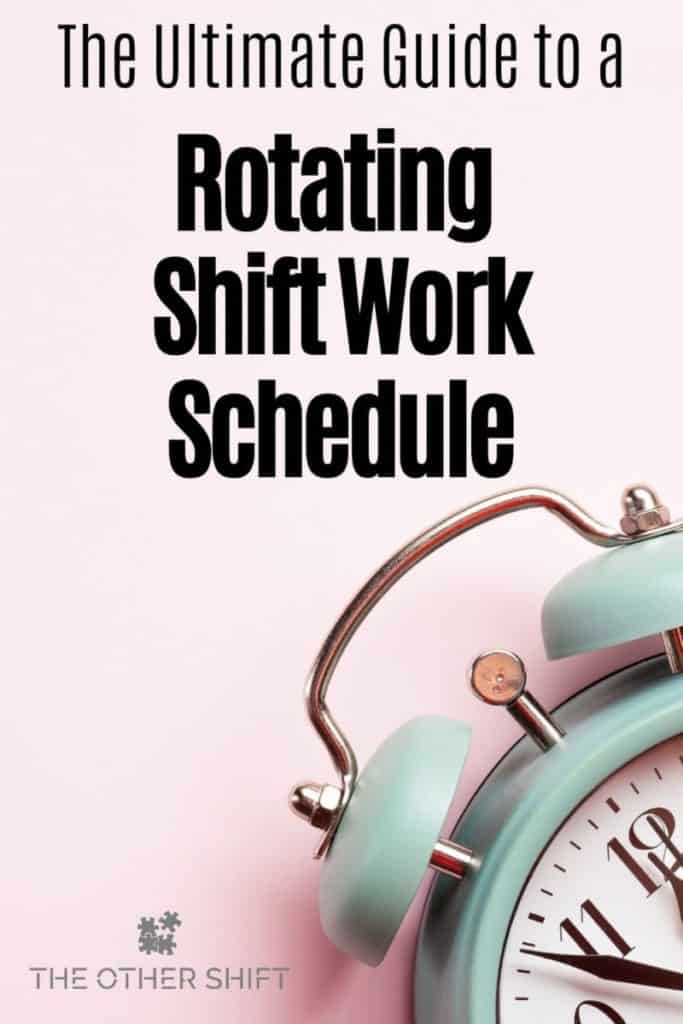Disclosure: This page may contain affiliate links, meaning we receive a commission if you decide to make a purchase through our links, but this is at no additional cost to you. Please read our disclosure and privacy statement for more info.
You have a friend who’s on a rotating shift work schedule and they seem to never miss a beat! How do they fit in work, errands, cleaning the house, let alone have a social life? There’s a secret advantage to working a rotating shift schedule and we’re here to share it with you.
A rotating shift work schedule is a system where employees move between the 1st, 2nd, 3rd or swing shifts at varying intervals. It was designed as a fair employee allocation method for businesses that operate with multiple shifts each day.

Depending on where you work and the specific industry, rotating shift work can be structured differently. Throughout this post, we will explore these differences, the benefits and disadvantages of this type of rostering system and why we think it’s a huge benefit to be working in this environment over those in the traditional 9-5 working space.
What is a Rotating Shift Work Schedule?
As an ER nurse working in a large tertiary hospital, rotating shift work is ever-present in my world.
Rotational shift work is the type of shift work where your employer has broken up the work hours of the day into different sections.
These sections are traditionally the 1st (early), 2nd (late) and 3rd (night) shift. The swing shift can also be included in the “rotation” too depending on your workplace.
If you’re not sure what the swing shift is, we’ve written a post titled, “What’s a Swing Shift? 5 Essentials to Managing This Schedule” and we encourage you to check it out briefly before progressing.
Staff are allocated to one of these shifts / sections, or randomly in my case as a nurse, for a set period of time. For some, this roster period could be a week, a month or even a couple of months. It comes down to staff requirements, business needs and also employee preference (if you’re lucky enough to have a say).
If you’re thinking, woooo slow down a minute gurl I’m getting confused…
Read another article of ours named: “What Do the Terms 1st, 2nd and 3rd Shift Actually Mean?”
It will give you a great introduction to these shift types, making understanding rotating shift work much easier.
Good to know…
Not all rotating workplaces are 24 hours in nature. This type of shorter work schedule is called “partial” or “semi-continuous” and can run 2 or 3 shifts per day (normally 8 hours in duration) with or without weekends.
[VIDEO] – The Complete Guide to Rotating Shift Work
What About a Rotating Shift Work Schedule Without Set Periods of Work?
For some workplaces, there is no set period of time a staff member would spend working a particular shift.
Using my workplace as an example, our roster is typically made up of a random combination of 1st shifts, 2nd shifts, 3rd shifts and also swing shifts. While you might think this seems crazy and how could you possibly manage this, there are definitely advantages to this work arrangement.
There are some minor disadvantages too, but we’ll explore both sides of the fence a little later on.
I should point out though there is one exception. Night shift. Some staff will purposefully request 3-4+ nights in a row in order to establish some normality within their body clock.
Most businesses are accomodating here, as they know the strain it can place on a persons body and mind if they are constantly switching between sleeping during the night and day.
But for most, there is no rhyme or reason why their roster looks the way it does. Those allocating the roster most likely need to have different skill mixes, certain roles filled and responsibilities adhered too on each shift. A complex job that requires a very thorough individual!

Fixed Shifts vs Rotating Shift Work
What about fixed shifts?
The main difference with fixed vs rotating shifts is that while it still comes under the shift work umbrella, workers remain on one shift and don’t swap or rotate.
You are known to work either the 1st, 2nd, 3rd shift as three very distinct groups. People who work fixed shifts remain there until they intentionally choose otherwise.
While there are obvious advantages, such as being in tune with your body clock, having a routine and the ability to more accurately budget your finances, it doesn’t always work out that way and the downside can really impact some people.
If you’re a social person like me and you worked permanent 3rd shift from Thursday to Monday, my work life balance would be thrown out extremely quick.
We’ve heard of people who get “stuck” on a shift they don’t enjoy and don’t have any options to change. Rotating shift work allows you to be more dynamic and have variety in your day to day.
Good to know…
Every shift working facility and industry has its own reason for choosing a certain schedule. It’s important to think about these things and how it fits into your lifestyle, before signing up to a new shift working position.

Which Professions Work a Rotating Shift Work Schedule?
If you are new to this line of work and considering where to start, then you should find yourself a rotating shift work role in these industries;
- Nursing
- Medicine
- Radiography
- Contractor (machine operator)
- Production and factory workers
- Mining
- Construction
- Hospitality
- Industrial cleaners
- Utility company repair
- Emergency services
- Road work crews
- Aviation
- Business process outsourcing call center
- Aviation
Benefits to a Rotating Shift Work Schedule
Before we dive into the benefits and disadvantages of the rotating shift schedule, here is a post we published about night shift vs day shift in general. It’s titled, “Pros and Cons of Night Shift vs Day Shift. Who Wins? and it’s a bit of laugh to brighten your day. It also helps to understand why we recommend people should work both shifts from time to time…
So you might be asking, what’s the point of rotating shift work?
Why can’t everyone just be assigned to a particular shift when they get employed as a fixed schedule and that’s the end of it? Wouldn’t it be easier?
While yes, it would be easier on the roster manager in my experience, it doesn’t lead to positive morale or productivity, particularly within a 24-hour organization.
So for those of you that have embraced the rotating shift work schedule, here’s the secret advantage we wanted to share with you. It’s not everything you can get, as we’ve just focused on at work benefits, though it’ll give you a feel for what you could now achieve on a daily basis when at the workplace.
Rotating Shift Work Fosters Team Productivity
In most businesses, the senior staff will rotate onto a different shift, even if they don’t personally want to.
This fact alone is inclusive, fair and gives all staff the opportunity to not only learn from each other but to also experience the struggles and challenges each shift brings.
This can alter staff’s perception, allowing for greater respect for your colleagues and workplace. I’ve also personally found that you are more likely to work as a team in reaching set goals when you understand what really goes on when you may not be in the office place.
Related: Night Shift and Depression. Are They Linked?

Even Learning Opportunities
Often those who work the night shift miss out on vital information and education which typically happens during the day.
When working a rotating roster, this doesn’t happen to the scale it would in comparison to a fixed schedule.
Yes, staff still do “miss out” on in-house education, last-minute staff meetings and changes of policy at times, which typically happen when management are around. But this is short-lived for a specific shift or two, until you rotate back into a role where these individuals are now present (we also hope your business has an in house communication tool that they use – this helps greatly with knowledge sharing!)
An important thing to also note here is there is no disadvantage to working a particular shift in terms of education as all staff soon rotate and receive the same training. These sessions are normally done by the same person or group of persons so it’s unified and unbiased.
This is great for skill mix as each shift should be of a high standard.
You Don’t Become Stuck In Your Ways
Rotating shift work keeps things fresh.
Yes, most workers do have a preference for when they like to work, but a rotating schedule ensures people keep progressing, growing and moving together.
The attitude of “one shift is doing all the work” no longer makes sense and this, in turn, creates unity and respect.
This sort of attitude I’ve seen too frequently and it bothers me, so I’m a big advocate for the shift work scheduling system.
Related: Shift Work & Mental Health – What People Don’t Tell You
Boosts Worker Engagement
Does one shift always seem busier than another?
Rotating shift work gives everyone the opportunity to learn and develop their skills during these peak periods.
There is an unspoken opinion that everyone will get their chance at the same experiences in the workplace, which creates an even playing field for all staff.
Everyone Experiences The “Bad” Shift
In most shift working industries there is that one shift which nobody enjoys and is the least desirable. Either because it’s quiet or incredibly busy (depends on the persons mindset really).
Rotating shift work provides everyone, even the senior staff, an opportunity to undertake these shifts. This creates fairness and you should never complain to management that someone is being looked after or yourself treated unfairly.
An interesting note here, which is prominent in the hospitality industry, is people want to work the profitable shift – particularly when tips are expected.
If you work in a busy restaurant or bar, you would want this shift right? You don’t want the early shift when the restaurant is only half to a quarter full.
Rotating shift work allows all staff to work these shifts and have access to potential increased income.
Here is a link to 13 Advantages of Shift Work for Employees which gives even more reasons why shift work CAN be great for you.

Disadvantages to Rotating Shift Work Schedule
Despite my overwhelming enjoyment working rotating shift work, like anything, there are some perceived negatives you should be aware of.
Lack of Consistency for Our Body Clocks
This is probably the biggest disadvantage of working a rotating shift work schedule.
We have previously spoken a lot about this in, “How Long Does It Take to Adjust to Night Shift?”
But in summary, our body LOVES routine. It uses the light and dark signals to tell our body (and brain) exactly what it wants it to do at set periods of time.
When working on a rotational basis we are messing around with this very finely tuned system.
If you have a quick turnaround from one shift to the next, say 8-10 hours, in comparison to another rotating shift worker who only rotates every month, you will feel the effects of this very differently.
In the end, it all comes down to your sleep and are you getting enough?
If you are not, you’ll see an increased risk of being hit with some potential health-related conditions and illnesses. Shift work sleep disorder and insomnia seem the most common here. (source)
If you want to learn more about shift work sleep disorder we published a post that explains what it is, the signs and symptoms and how to prevent it. Check it out here.
[VIDEO] – How to Switch from Night Shift to Day Shift and Not Feel like a Zombie
Lack of Consistency for People Who Like A Set Routine
Are you a person who loves routine? Depending on how often you need to rotate you may struggle with this type of work. It’s funny though, after a period of time you will develop rituals in line with each shift.
For example, when working an early (1st), you may bring your workout clothes to work and complete an exercise class at the local gym straight after you finish. Before a late shift (2nd), you may meet your partner at their office and have lunch together before you start…
Despite no fixed routine, you can still have your go-to rituals which create small consistencies.
Change of Income
If you’ve worked the shift work game for a while now, I’m sure you’ve noticed that you will receive a bonus financially for working a 3rd shift and sometimes the swing shift.
If you are working a rotating roster, you’ll still get these bonuses but only when scheduled to work those shifts.
However, a very cool thing which may exist in your industry and is worth investigating is bonus pay during public holidays… even if you’re not working.
I know it seems crazy, but they take into account the fact rotating schedules are allocated by chance and reward you for missing out on that extra income. A fantastic present when you next look in the bank account.
Your Personal Life Can Take A Toll
If you’re used to having dinner with your family and spouse every night at 6pm, things can and will look very different.
Working rotating shifts does force us to think outside the square to keep our lives away from work interesting. This applies to not only our intimate relationships but also with our friends and wider family.
There will be some events you simply can’t attend due to work commitments. And while that’s not ideal, you can’t let it beat you.
Use the non-traditional days and times of the week to complete special activities. Here are a few posts which can help get those positive juices flowing:
- 5 Impressive Date Ideas For Those Working Opposite Shifts
- Shift Workers Guide To Valentines Day: Work And Be Romantic
- Night Shift Is Killing My Marriage. How To Stop It Happening
- Shift Work Single Life: How To Make The Right One Stick
Unable to Plan Ahead
How far into the future is your roster? A few weeks, a month or maybe more.
Depending on how far ahead you are given a timetable will dictate how you plan and organize your life.
Both personally (can I go to that party?) and professionally (can I make that basic life support training session?). This aspect of rotating shift work can be very annoying.
If you’re trying to book a vacation, plan a party or organize home maintenance activities there is only so far into the future you can plan. This can feel restricting, particularly those who are big organizers!
Summary: The Complete Guide To A Rotating Shift Work Schedule
Well, for those new to the rotating shift work schedule game, we hope you feel much more comfortable understanding what this rostering schedule is actually about.
Yes there is bias here, as I’ve only ever known working this way.
However, my husband has experienced both sides of the fence and from our conversations together, we couldn’t recommend this form of working arrangement enough.
If you’re reading this as an existing rotating roster worker and would be kind enough to share your views in the comments below, we’d be very grateful!
Cheers,

Disclosure: This page may contain affiliate links, meaning we receive a commission if you decide to make a purchase through our links, but this is at no additional cost to you. Please read our disclosure and privacy statement for more info.


Thank you for the reassurance. I’m starting my first Rotation shift job this Thursday. Rotated between two shifts (Days, Nights) with two, to three days in the between shifts off.
I have Bipolar Disorder and I am doing wells I take medication and my whole life know is revolves around health and wellness. I see my Doctors regularity and get blood work as needed.
I’m am concerned with messing up my sleep schedule but I need to be working. Not a lot of work to be be picky over considering Covid.
Thanks and appreciate your thoughts
Hi Leslie,
Thanks for your honesty.
I’m sure by now you have started your job. How is it going?
When I consider my own rotating shift work job I think about a few main points (which I help these assist you on your “not so new job”
1. Aim to sleep between 7-9 hours sleep. If you struggle actively do something about it. Start with sleep aids such as eye mask, blue light blocking glasses to create your own sleep oasis.
2. Swap smart. Take a look at this post which will assist you in swapping from night to days and also includes an insightful video.
3. Be social. Whether that’s a walk, dinner or even a zoom chat having something to look forward to makes it all a lot easier.
Best of luck. Hope this helps.
Emma